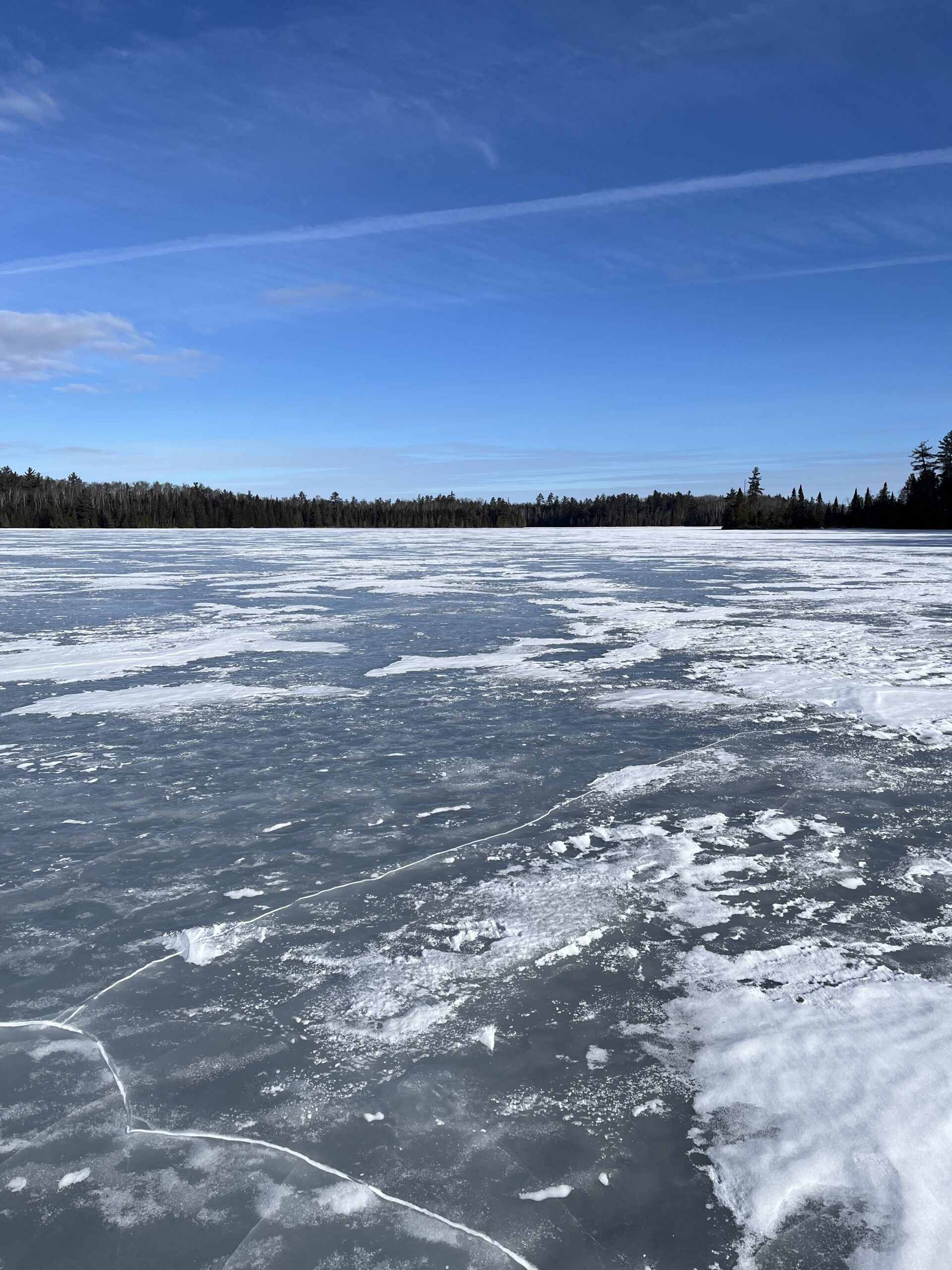3/26/24 – How fitting that the first real snowstorm of the “winter” comes after the spring equinox. So far we’ve received 10 inches of snow from this storm, and it’s still coming down. -Jessica
Author: Sawbill
Cold Snap
3/22/24 – Temperatures have remained below freezing this past week with a few lows dipping down to single digits and one morning briefly below zero. The lake has firmed up nicely and back to being quite slick with the sun working it’s Zamboni magic once again. No slushy top inch like we were seeing last week. Even with the cool temps, it seems we lost a little ice since our last report with four test holes revealing 11-1/2 to 13-1/2 inches. -Jessica


Let the Countdown Begin!
3/13/24 – This afternoon we happily welcomed a new addition to the ice measuring tool kit. The fresh out of the box auger easily cut through a handful of test holes with it’s razor sharp blade to reveal between 14 and 15 inches of ice on the south end of the lake. The ice seems pretty solid out there still, but the top inch is more slush than ice at this point. Things have been changing quickly the past few warm sunny days and I’m certainly not enticed to go on any long lake walks like I did just a few days ago.



Looking at the extended forecast however, this ice melting extravaganza might come to a screeching halt over the weekend with lows predicted in the teens and single digits through early next week. -Jessica
Tables Have Turned
3/12/24 – And just like that, our shimmering smooth ice has transitioned to crunchy puddles, which will likely loose their crunch by end of day.
Yesterday we reached a high of 59° which produced just too much water on the ice for this mornings measly 27° low to fully refreeze. -Jessica
Smooth Ice
3/11/24 – The past handful of days we’ve noticed the higher angle of the sun having a Zamboni like effect on Sawbill Lake. Many of the bumpy ridges that were present a week ago have been smoothed over and refrozen by the consistently cold nights. To give an idea, the lake surface around mid day is not dissimilar to a popsicle that has been recently pulled out of the freezer and licked a few times. -Jessica




Coffee was spilled twice in the making of this post. It’s slick out there!
Supply Run
3/7/24 – Most people get their mail delivered to a mailbox at the end of their driveway, or straight to their door. In our case mail and other shipments get dropped off in the bustling metropolis of Tofte, either at the Post Office, or at small shed we rent from the Tofte General Store. On a rare occasion a wayward substitute delivery driver will make their way up the 24 miles of the Sawbill Trail with a wild look in their eye, but for the most part we spend a lot of time with large boxes of t-shirts and merchandise in the back of our vehicles, especially in the lead up to spring.

Yesterdays “town trip” included picking up a shipment of vinyl ester resin and other supplies that Dan uses to refurbish the used canoes we sell on the website. He’s been steadily cycling the canoes through the workshop since mid-November and is getting down to the last couple batches before they’ll all be done and ready for their new homes. -Jessica


Extra Day, Extra Lake Walk
2/29/24 – In celebration of Leap Day the dogs and I went for a quick walk on the lake before the breeze picked up and the clouds filled in. We can report a skiff of snow along the shorelines, and lots of uneven icy patches once out on the main part of the lake. Great conditions for practicing your penguin walk. In the woods we found about 3 inches of snow in most places, but bare ground is starting to show through in areas with more sun exposure. -Jessica


Reflecting on the Weather
2/13/24 – Unlike most of the state, we’ve had a consistent, although thin, layer of snow blanketing the forest since the beginning of January. Last weeks warm up was beginning to threaten that trend with multiple days of rain resulting in patches of bare ground opening up here and there. This past weekend, however, temperatures dropped back below freezing, the rain switched over to snow, and those patches of ground were tucked back under a white blanket of snow. Lake travel also greatly improved with the return of cool temperatures. -Jessica


Preparing to Book Overnight BWCAW Permit
1/29/24 – This Wednesday, January 31st at 9am CST, permits will open up for sale through the Boundary Waters Canoe Area Wilderness section of recreation.gov. In preparation for the big day check out this link to our BWCA permit reservation how-to video.
For more information about permits and how they work, check out the “permit reservations” section of our website, and as always feel free to call or email with any questions!
We have availability for all canoe types for all dates at this point, so you can book your permit with confidence that we will have a canoe for you!
-Jessica
Beautiful Blue Skies on the Sawbill Trail
1/20/24 – Getting ready to go for a walk the past few days has been a bit more of a production now that sub zero temperatures have finally set in. Key ingredients for more than a short walk outside include; a neck gator, face mask, stocking hat, ski goggles, first jacket layer, mukluks, insulated bibs, outer jacket, glove liners, and finally big furry choppers. Dawning all this gear is for sure worth the effort once you’re out squeaking around on that cold snow (fellow winter lovers, you know the sound). Another big bonus to this cold snap has been the beautiful blue skies that have accompanied it. -Jessica

